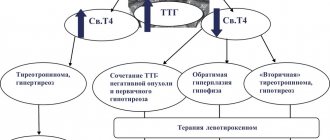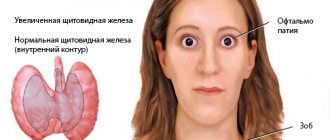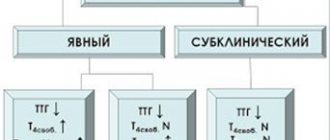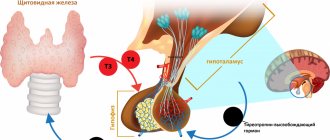Diffuse toxic goiter (DTZ, Graves-Bazedow disease) is an autoimmune disease characterized by persistent pathological hypersecretion of thyroid hormones and, as a rule, a diffusely enlarged thyroid gland (thyroid gland).
Goiter is a pathological enlargement of the thyroid gland, without specifying its functional state. The normal volume of the thyroid gland, determined by ultrasound, should not exceed 25 ml in men and 18 ml in women. Palpation of the thyroid gland, being the main method of clinical examination of the thyroid gland, does not allow determining its volume and has no independent significance for the diagnosis of goiter.
Thyrotoxicosis is not a disease, but a clinical syndrome caused by persistent pathological hypersecretion of thyroid hormones. The term hyperthyroidism means an increase in the functional activity of the thyroid gland, which can be pathological (thyrotoxicosis) and physiological (for example, during pregnancy). The severity of thyrotoxicosis is assessed by the clinical picture and the presence of complications associated with the disease (atrial fibrillation, dystrophic changes in internal organs, thyrotoxic psychosis, etc.).
The cause of thyroid disease is a defect in the immune system, leading to the formation of antibodies that stimulate the production of excess amounts of thyroid hormones.
Antibodies are proteins produced by cells of the immune system - lymphocytes. These antibodies are able to bind to TSH receptors (a hormone that normally regulates thyroid function) and, like a wolf in sheep's clothing, uncontrollably stimulate the production of thyroid hormones. The thyroid gland simply “does not understand” who is stimulating it. Hence they received the name – antibodies to TSH receptors (ATrTSH).
Circulating antibodies are detected in 50% of relatives of a patient with DTG. Sometimes there is a combination with other autoimmune diseases (chronic adrenal insufficiency, type 1 diabetes, etc.). Women get sick 5-10 times more often than men. As a rule, DTZ manifests itself in young and middle age.
Diagnostics
To confirm the diagnosis, the patient will have to undergo several examinations:
- Ultrasound perfectly detects diffuse changes in the parenchyma of the thyroid gland. The method is one of the safest.
- Echography is performed when there are no signs of diffuse changes in the thyroid gland, but compactions are palpable, and tests performed show an imbalance of hormones.
- MRI allows detailed examination of the parenchyma.
The patient also undergoes a series of tests.
What does an ultrasound of the thyroid gland show?
Ultrasound examination of the thyroid gland allows you to obtain accurate information about its condition. First of all, attention is paid to the location, shape, contour and, of course, the size of the gland.
In terms of overall size and volume, the gland may be normal, enlarged (hyperplastic), or reduced (hypoplastic). There are also cases of asymmetry of the gland, absence of part of the lobe (hemiagenesis) and complete absence of the gland (agenesis-aplasia).
Thyroid volume levels vary depending on age and gender. The upper limit for women is 18 cm3, for men - 25 cm3. As children get older, the glands grow.
Treatment
If patients do not ignore the signs of diffuse changes in the thyroid gland, then we can limit ourselves to prescribing medications. Individual treatment is selected for each patient, taking into account the causes of the disease.
As an additional measure, doctors recommend vitamin therapy.
Surgery is recommended if the nodes are too large. During the operation, the entire affected area of the gland is removed. An endocrinologist treats this disease.
Symptoms
General symptoms of pathological changes in the structure of the thyroid gland manifest themselves in the form of increased fatigue and muscle weakness, and also occur:
- decreased performance and concentration;
- depressed state, and a tendency to depression ;
- memory deteriorates;
- nail plates and hair become more brittle and dry;
- hot flashes may be followed by feelings of extreme cold;
- aggressiveness increases;
- an inexplicable and sudden increase in body weight occurs;
- abnormal frequency of colds or other illnesses.
If diffuse changes have led to the development of a goiter or nodes of quite impressive size, then typical complaints may be:
- feeling like there is a lump stuck in the throat;
- causeless cough and fever;
- difficulty breathing and swallowing;
- headaches and neck discomfort.
When diffuse changes provoke hyperthyroidism , a person may experience tachycardia , palpitations , frequent hot flashes, exophthalmos (bulging of the eyes), increased excitability, emotional lability, irritability and aggressiveness.
Prevention
To protect your health, you should not turn a blind eye to signs of diffuse changes in the thyroid gland and put off visiting a doctor. Despite the fact that today medicine makes breakthrough after breakthrough, specialists have not been able to determine the nature of thyroid disorders, and therefore there is no sure way to prevent such ailments. But not everything is so pessimistic: it is still within our power to prevent some conditions. For example:
- If there have been cases of such diseases in the family, you need to try to protect yourself from exposure to provoking factors - for example, to prevent exposure to toxic substances.
- To prevent iodine deficiency, you need to eat foods that contain this substance: seafood, seaweed, fatty fish, apples, plums, apricots and grapes, milk, cheese and cottage cheese. You can also replace regular salt with iodized salt.
- Excess weight often provokes thyroid diseases, so you need to reconsider your diet and choose the appropriate type of physical activity.
- If the diagnosis has already been made, do not forget to regularly visit a specialist and do an ultrasound to prevent the development of pathology.
Changes in the thyroid gland on ultrasound: what to do
The thyroid gland is the “conductor” of all metabolic processes in the body. The consequences of violations in her work are reflected literally on her face, figure, mood and overall well-being. However, vivid symptoms do not appear immediately, but only when the “limit” of compensatory capabilities is significantly exceeded. Until then, changes in the thyroid gland often become an “accidental finding” on ultrasound.
What are there
1.Enlarged thyroid gland
One of the most common ultrasound findings. The most common causes of such deviations are: autoimmune pathology and iodine deficiency. The result can be a deficiency of thyroid hormones.
2. Focal changes
These include cysts and nodes. Both of them can be benign (95%) and oncological in nature, as well as producing hormones or “hormone-neutral”.
Benign “neutral” formations in themselves do not pose a threat, as long as their size does not “interfere” with the work of this or neighboring organs. And in conclusion, the ultrasound can be described as:
- nodes,
- cysts.
Hormonally active formations pose a much greater danger to health. Even a relatively small such node or cyst can lead to serious consequences for the body, which requires immediate corrective measures.
The occurrence of focal changes is most often due to:
- iodine deficiency,
- exposure to ionizing (radiation) radiation,
- toxic substances
And the “treatment strategy” varies from regular observation (screening) to surgical intervention.
What to do
Of course, detection of abnormalities in the thyroid gland by ultrasound is a reason to immediately make an appointment with an endocrinologist. It’s better to go to an appointment immediately with the test results.
1. Complex “Thyroid examination, screening”
Includes:
- determination of the level of free (active) fraction of thyroid hormones
- thyroxine (T4) and
- triiodothyronine (T3).
At the same time, pathology is not always reflected at the level of both indicators at once. For example, normal T4, with a decrease in T3, may already be a sign of subclinical (hidden) hypothyroidism.
2. determination of the level of the “controlling” hormone of the pituitary gland
- thyroid stimulating hormone (TSH)
Exceeding the standard limits here indicates a lack of thyroid hormones, and a decrease indicates an excess of the latter. Such fluctuations reflect the physiological “attempt” of the pituitary gland to “stimulate” or, conversely, “slow down” the activity of the gland. And they are not associated with it only in the case of pituitary adenoma.
3. determination of the level of antibodies to
- thyroid peroxidase (Anti-TPO) and
- thyroglobulin (TG).
An excess of both indicates the presence of immune aggression against thyroid tissue (autoimmune process), which over time leads to its destruction and hormone deficiency.
Unfortunately, the pathology has no specific treatment, and the only corrective measure today is lifelong use of hormonal medications.
2. Complex “Examination of the thyroid gland”
Compared to the previous version of the survey, it was added to determine the level:
1. thyroid tumor markers
- thyroglobulin and
- calcitonin.
- antibodies to thyroid-stimulating hormone receptors (anti-rTSH)
They play a significant role in the diagnosis of hyperthyroid conditions, and in particular Graves' disease.
The results of such a comprehensive examination of the thyroid gland, in most cases, are sufficient to make a diagnosis. This means that treatment can begin literally “from the doorstep” of the endocrinologist.
Forecast
The prognosis of diffuse toxic goiter with adequate and timely treatment is favorable, although it should be taken into account that the postoperative period is dangerous for the development of hypothyroidism.
Without treatment, the outlook is unfavorable, since thyrotoxicosis gradually causes cardiovascular failure, atrial fibrillation, and exhaustion of the body.
After treatment of thyrotoxicosis and normalization of thyroid function, the prognosis of the disease is favorable; most patients get rid of cardiomegaly and restore sinus rhythm of the heart.
Complications
Due to late diagnosis of diffuse toxic goiter or inadequate treatment, the disease progresses, exhibiting complications:
- thyreostatic myocardial dystrophy, atrial fibrillation, pulmonary edema;
- toxic hepatosis;
- osteoporosis;
- diabetes;
- adrenal insufficiency;
- myopathy (muscle weakness);
- psychosis;
- hemorrhagic syndrome (blood clotting disorder);
- pernicious anemia;
- thyrotoxic crisis.
Thyrotoxic crisis is the most severe and life-threatening complication of diffuse toxic goiter, which develops when symptoms suddenly worsen, especially a few hours after partial surgical removal of the thyroid gland. A crisis can be triggered by infections, stress, increased physical activity, various surgeries, and even tooth extraction.
With the development of a thyrotoxic crisis, a powerful release of innumerable active thyroid hormones occurs, as a result of which patients become restless, they experience a significant increase in blood pressure, then overexcitation begins, and all symptoms intensify: tremor, palpitations, muscle weakness, diarrhea, nausea, vomiting. Further excitement is replaced by stupor, loss of consciousness, the patient falls into a coma and dies.
Symptoms of the disease
At the initial stage of development of the disease, symptoms may be absent or their manifestation will be insignificant and unnoticeable. Nodular goiter of the 2nd degree already implies the presence of noticeable deviations in the functioning of the body. As the disease progresses, the number and severity of symptoms will increase.
Multinodular goiter is characterized by:
- hoarseness of voice;
- cough of unknown origin;
- difficulty swallowing;
- dyspnea;
- pain in the organ area;
- difficulty breathing;
- loss of appetite, weight loss;
- protrusion of eyeballs;
- emotional instability;
- menstrual irregularities;
- hair loss and dry skin.
Treatment of diffuse nodular goiter of the thyroid gland in a clinic on the Yauza
We successfully diagnose and treat multinodular, colloid and toxic goiter. By visiting the clinic, you entrust your health to high-level professionals. Our specialists have extensive experience in this field. Many doctors have significant scientific achievements and degrees.
The clinic is equipped with the most modern equipment for diagnostics and surgical treatment. Our patients recover after operations in a comfortable hospital, where their recovery is constantly monitored by the attending physician. We have a modern rehabilitation complex where you will be professionally helped to restore your health faster.
You can see prices for services
Classification
Diffuse toxic goiter can be classified differently, the severity of which is determined by the size of the goiter and the syndrome of thyrotoxicosis.
For approximate palpation determination of the size of the thyroid gland, several differentiations are used.
The classification of endemic goiter according to O.V. continues to be used most often today. Nikolaev.
- 0 degree - the thyroid gland is not visualized or palpated;
- I degree - the gland is not visualized, but the isthmus is palpated and visualized during swallowing;
- II degree - the thyroid gland is visible when swallowing, palpated, but the shape of the neck is not changed;
- III degree - the gland is visualized and the contour of the neck is thickened;
- IV degree - large goiter, disrupts the contours of the neck;
- V degree - a huge goiter, compressing the trachea and esophagus.
WHO classification of goiter (from 1992)
- 0 degree - the thyroid gland is palpable, the size of the lobes corresponds to the patient’s distal phalanx;
- I degree - the lobes of the gland are larger in size than the patient’s distal phalanx;
- II degree - the thyroid gland is visualized and palpated.
Thyrotoxicosis is classified:
Severity of thyrotoxicosis in variant I:
- Mild degree - with a pulse rate of 80-120 beats per minute, there is no atrial fibrillation, there is a sharp weight loss, decreased performance, and slight tremor of the upper extremities.
- Moderate degree - with a pulse rate of 100-120 beats per minute, an increase in pulse pressure, absence of atrial fibrillation, weight loss of 10 kg, and loss of strength are observed.
- Severe degree - with a pulse rate of more than 120 beats per minute, atrial fibrillation, thyrotoxic psychosis, degenerative changes in parenchymal organs are observed, body weight is sharply reduced, and the ability to work is lost.
Severity of thyrotoxicosis in variant II:
- The mild (subclinical) degree is determined mainly according to hormonal studies against the background of an erased clinical picture.
- The average (manifest) degree is characterized by a detailed clinical picture.
- Severe degree (complicated) is manifested by heart failure, atrial fibrillation, relative thyroid deficiency, dystrophic transformations of parenchymal organs, psychosis, and sudden loss of body weight.
Why does pathology appear?
The exact reasons for the development of nodular goiter have not been established. It is known that people who suffer from iodine deficiency, have been exposed to radiation, or have a genetic predisposition are at risk. Also, diffuse nodular goiter can develop while taking certain medications, as a result of infection or working in unfavorable conditions.
Without proper treatment of nodular goiter of the thyroid gland, the tissues quickly grow and begin to put pressure on the organs of the neck. In addition, there is a high risk of pathology degenerating into a malignant process.








